The first numbers are rolling in from the first comprehensive analysis of the country’s first connected bicycle boulevard network, and they show some clear problem spots.
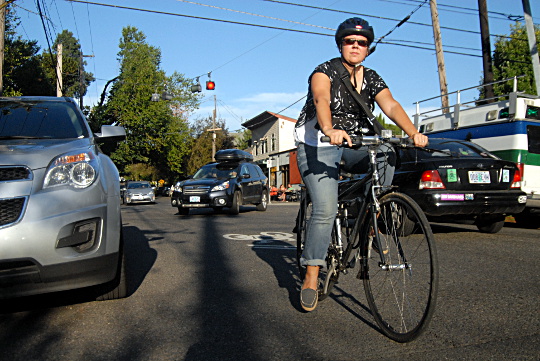
The side-street bikeways are known in Portland as neighborhood greenways to capture their appeal as places to walk, jog, shoot hoops and so on. But the City of Portland’s project shows that six — inner SE Clinton, SE Lincoln near 53rd, NE Tillamook near Grant High School, SE 86th near Powell, inner Northwest Johnson and upper NW 24th — clearly fail national standards for auto counts on bike boulevards.
The national standard, created by Portland and other cities in the form of the NACTO Urban Bikeway Design Guide, says “bicycle boulevards should be designed for motor vehicle volumes under 1,500 vehicles per day, with up to 3,000 vpd allowed in limited sections of a bicycle boulevard corridor.”
More than 10 percent of counts on the Clinton and Lincoln/Harrison greenways between 2006 and 2014 cross that red line, as well as about eight percent of counts on Tillamook.
Most of the Clinton and Lincoln/Harrison routes don’t even make it into the green zone. Less than half of their motor vehicle counts were below 1,500.
As for Northwest Portland’s small network of greenways, high-traffic stretches on 24th and on Johnson mean that 10 percent of counts in the entire quadrant exceed 3,000.
Portland Bicycle Planning Coordinator Roger Geller presented the findings Monday at the Oregon Active Transportation Summit, noting that the system included points with “higher-than desired traffic volumes pretty much across the board.”
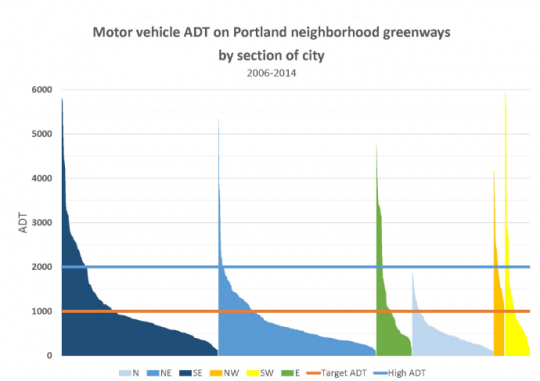
He described inner Southeast and Northwest as “a real problem area” for neighborhood greenways.
The study also found high traffic on much of the 130s neighborhood greenway, which hasn’t yet been built. Geller said those stretches are likely to get bike lanes instead.
Advertisement
The data also showed some clear bright spots. Every single auto count on the North Portland, Going, Holman and Salmon/Taylor greenways measured fewer than 1,500 motor vehicles per day. That’s thanks in some cases to traffic diverters that make the streets impassible to cut-through auto traffic while still allowing local car access.
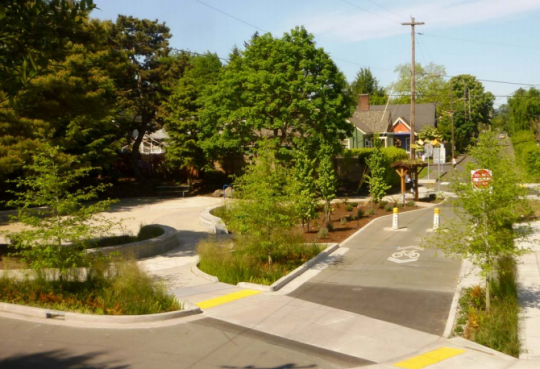
(Photo: City of Portland)
The city’s findings so far echo concerns from advocacy groups BikeLoudPDX and the Bicycle Transportation Alliance that Southeast Clinton Street in particular is a bikeway in name only and is failing to attract the new bike users necessary for the city to meet its auto reduction goals.
However, Monday’s findings also showed something else: despite those problems, Southeast Clinton Street near 26th Avenue has become as popular a place to bike (at least among the people who currently ride bicycles) as it is to drive.
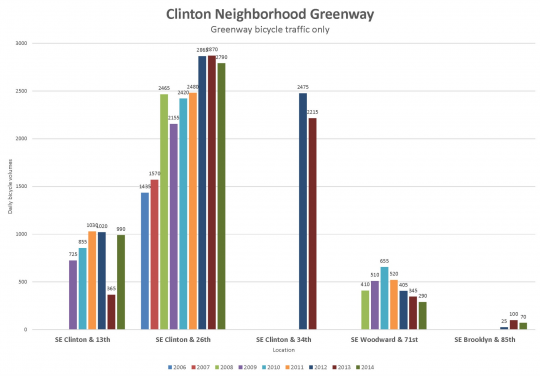
That raises a different question: if many people are making do with the sub-par biking conditions on Clinton, is it more important for the city to spend its limited time, money and political capital expanding the greenway network elsewhere?
“Northwest and East Portland are not too happy right now for our greenways, and we could probably be doing better citywide,” Geller said Monday.
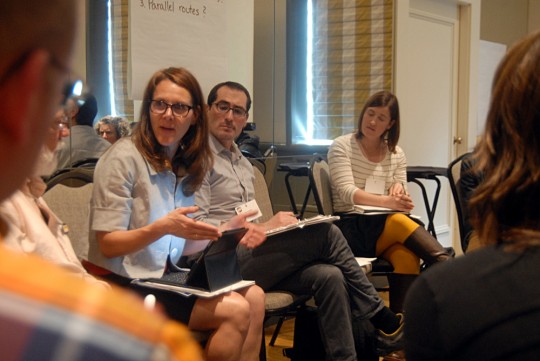
(Photo: M.Andersen/BikePortland)
Another major safety issue isn’t addressed by these figures: traffic speed. Portland Active Transportation Division Manager Margi Bradway, who conceived the neighborhood greenway analysis project last fall, said data about auto speeds on neighborhood greenways will be ready for public release in a few days.
Geller said the full neighborhood greenways report might or might not include recommendations for action to Portland City Council. He wasn’t willing to commit Monday to a release date.
“We will have the report in the future,” Geller said. “It’s really complex and there’s a lot of issues to address.”


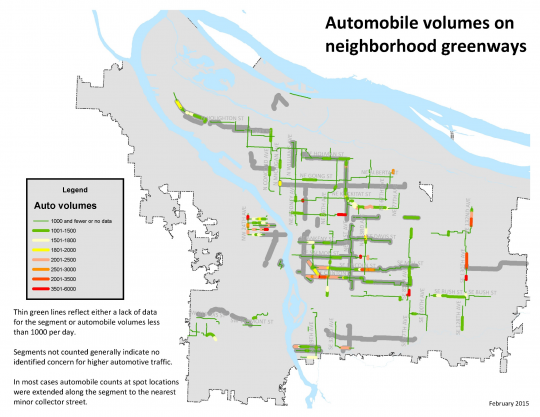
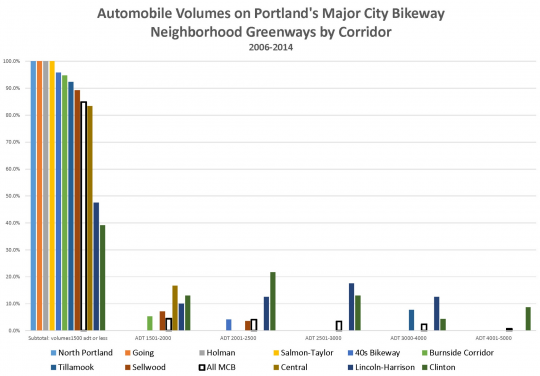
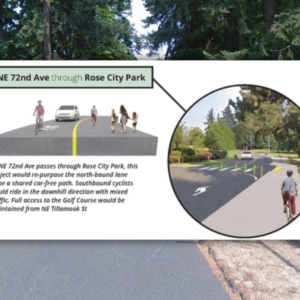
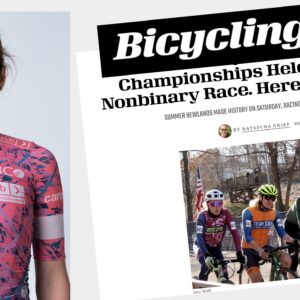
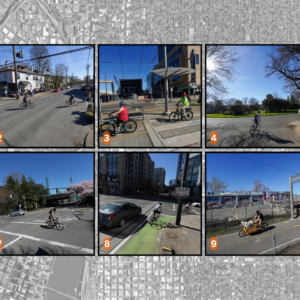

Thanks for reading.
BikePortland has served this community with independent community journalism since 2005. We rely on subscriptions from readers like you to survive. Your financial support is vital in keeping this valuable resource alive and well.
Please subscribe today to strengthen and expand our work.
If the diverter at Holman/13th includes a park, was it paid for through both PBOT and Parks? Perhaps this can be one way to get funding for this type of diverter sorely needed on Clinton, Ankeny etc.
PBOT, BES, and Parks.
Surely I am not alone in having repeated experiences with aggressive drivers on Clinton. However things are going there—despite it all—somebody is going to get hurt.
That raises a different question: if many people are making do with the sub-par biking conditions on Clinton, imagine how many more would be riding there with the simple addition of some traffic diversion?
5% reduction in automobile traffic =? 10% increase in bicycle traffic.
The spot at SE 85th by the DMV is ridiculous. It’s mostly people using it as a cut-through from Powell to 82nd. If they put a diverter for westbound traffic at 85th or 83rd – it would still allow access to Eastport Plaza and stop a lot of the cut through.
SW needs more greenways.
Yes, the top map is pretty sobering of the huge gaps we have in greenways.
glad we’ve got some tangible quantitative numbers to back the shit show on clinton. for the love of safe transportation, through some crowd-source-community-engaged diverters up and call it a day.
I got 5 on it.
I’d throw in $20 easy…
Crowd funding infrastructure improvements is a terrible idea. Perhaps one of the worst ideas for public funding period.
First it would cost more, because the improvements would have to be approved through an extra level of bureaucracy which is currently the same level that gives or doesn’t give us the current ideas.
And if it turns out to be even relatively successful, you can wave good by to all public funds for non auto infrastructure improvements- they’ll do so and even push it as being more democratic.
I know it sounds really good, but it a clear case of be careful of what you wish for.
You touch on bike volumes and traffic speed a little bit here, but they do give a fuller picture. When Clinton has a lot of cars on it, it still feels safe if there are also a lot of bikes on it, because cyclists are comfortable setting the pace. Center never feels as safe, even if there aren’t as many cars as Clinton, because the ratio is out of whack. It’s not a bike boulevard, it’s a car street where you can bike in the parking lane. Few dare take the lane through the 70s. That’s “a bikeway in name only.”
People vote with their pedals, and bike volumes show that Clinton is a success, even while failing by national standards. I’d love to see Center and Woodward fail as well as inner Clinton, for all its problems.
I live off Center and bike Clinton often… Center is much nicer than Clinton because there’s more road for those impatient drivers to pass you… the sheer volume of cars on Clinton is discouraging… there just isn’t much traffic on Center so I don’t feel like people are wanting to run me over as often while I’m riding over the sharrows… Center also isn’t an alternate route for either Powell, Holgate, or Foster because they never have enough traffic for people to divert to the greenway…
More road, but that’s my point; if cars can travel as fast as they want, and never need to wait awhile to pass you, then it’s a car boulevard and not a bike boulevard.
The section on speeds is a different map, not yet released. On Clinton, for example, east of Caesar Chavez in the 40’s the numbers of cars is hovering around 1100, but the travel speeds are WAY too high.
way too high… it’s 20 mph through there but I constantly get tailgated and passed too close when I’m doing 19 mph…
There are no diverters along any of the NW bikeways mentioned. I think construction of a few well-placed diverters could go a long way in quieting those routes. And maybe if they do that they can then turn some of the stop signs–you can’t go more than two blocks without hitting a stop sign along most of those lengths (that’s why when going north, a lot of us take NW 25th because it’s faster and less frustrating).
Totally agree. My commute home includes both Johnson and 24th, and having to listen to cars speed behind me trying to get to the stop sign before me is just so unpleasant. There’s also the fact that you have to cross 16th (I think? First road west of I405), 18th, 19th, 21st, and 23rd … I’d love if that could be made less stressful, unsure how though.
But having a few diverters to eliminate cars cutting through on Johnson would be massive. Everett treatment for Glisan would also be nice 🙂
How about a greenway on Flanders with a bike/ped only bridge on 405?
Let us spend a few 100K on the current NW system and get the current routes up to par first. There are parallel bike lanes there that work just fine for now. 24th has traffic circles that can be converted easily enough, and a few curb extensions at the high volume streets. A few one way couplets would do the trick for on Johnson and Marshall for fairly cheap.
This report is a little disingenous because technically NW has no “neighborhood greenways” (paikiala feel free to correct me). See this page: https://www.portlandoregon.gov/transportation/article/391019
All of these streets (Flanders, Johnson, Marshall, Overton, Raleigh, 24th) are bicycle boulevards with little more than sharrows and signage (except for the physical diverter at Marshall and 10th). It would be wonderful to see just one of these upgraded to full NG status but the density of destinations and pedestrian activity in NW makes it more complicated to scale the typical greenway model in a more urban neighborhood.
Flanders will be the first opportunity to pioneer this urban greenway model. For example, turning stop signs doesn’t work if all you’re doing is promoting drivers to speed without any stop control, to the detriment of pedestrian safety. That’s where physical diversion comes in, but you still need to allow adequate access to any garages along the street.
Is there anywhere online that describes what an “urban greenway model” would look like? I have a hard time imagining how the future Flanders Greenway will be much better than what’s there already (the bridge over 405 excepted). My big worry is that it’s just going to be a bunch of sharrows with stop signs every block or two.
technically Clinton isn’t a greenway… nor the section through Ladd’s…
Reza, neighborhood greenways and bicycle boulevards are one and the same. Those in NW Portland are simply very minimal facilities built to earlier guidance and with few of the treatments that define today’s best practices for bicycle boulevards (as identified in the NACTO guide and Portland Bicycle Plan for 2030)/neighborhood greenways (as we now call them in Portland).
Reza,
PBOT will call them all the same thing in the future, neighborhood greenways, but they have been built over time and about every 10 years the standards changed. few, if any, of the older greenways/boulevards were ever upgraded when new iterations of standards changed. There have been piecemeal upgrades here and there, but nothing holistic.
Even the best Greenways (I’m looking at you Going) are still places where you rarely see children riding unaccompanied. And the adult chaperones look vigilant, not relaxed. Speed bumps before the stops signs on the cross streets would make a big difference.
Yes. Parenthood has given me a new perspective on “acceptable” bike infra. My family depends on many these streets for school trips and they are not easily safe for young riders. We’ve taken to riding parallel routes where more stop signs, narrower roads, and less through lines keep drivers more vigilant.
My bellwether is basketball hoops in the parking: if kids feel safe enough to play hoops on the street, that’s a good sign.
This should be the standard for greenways, not an auto count, particularly since this number does not take into account many other more important variables. Can kids play basketball on this street?
While I agree in theory, in reality a street designated for through bicycle transportation should not have kids playing basketball on it. There’s a house on NE Tillamook where this happens quite frequently, and the kids are usually not paying attention, forcing cyclists to slow down and alert them.
This is one reason I’d love to see protected bike lanes on arterials in addition to the neighbourhood greenways – more experienced cyclists could use the arterial routes for commuting and other forms of travel/transportation, while inexperienced or more leisurely riders could use the greenways and take it a lot slower and easier.
Great- let’s have an anti-basketball on greenways initiative. Damn kids playing.
He’s not saying keep kids off Greenways, he’s saying if there were parallel routes for fast bikers, the basketball games would be even more welcome.
So fast bikers get to determine who is and is not welcome on the neighborhood greenways? Those kids are going to play basketball whether you like it or not. Where is the right to bike fast enshrined besides this blog?
I think you misunderstood my comment. I’m in full support of kids playing basketball on the street. What I think is ridiculous is that the city designates such streets as the only reasonable route for bicyclists to use for transportation. I feel it might be a lot better if we could designate such streets for slower and more inexperienced riders who may have more time to reach their destination – thus mixing well with neighbourhood activities – while also providing a network of protected bikeways on arterials for the rest of us.
Do you come to this site just so that you can find something to upset about?
Kyle,
You’ll need to cite where PBOT has designated greenways as the ‘only reasonable place for bicyclists to use for transportation’.
The 2030 plan clearly lays out a variety of facilities for a variety of users.
Cross street traffic is horrific on Ankeny and, to a lesser extent, on Tillamook as well. On Ankeny it seems to mostly be hurried Central Catholic HS parents – it stopped nearly entirely during Spring Break.
PBOT has several ideas to address this issue and has been hearing about it more.
I spoke to Rich Newlands and other PBOT staff at the Rodney event last night and we came up with the idea of using stop bars or thermoplastic crosswalks to give drivers a sense that they are entering a different environment.
An especially Portland way to do it would be stop bars with green thermoplastic dashes on the top of them, indicating that you are about to enter a greenway. Here is a concept drawing:
The idea is to have something besides signage, to appeal to drivers who aren’t seeing the stop signs today.
Except most of the stop signs are quite visible, otherwise stop bars would have already been added.
I don’t think folks blowing the signs don’t see them, they just think blowing them is ok. The point of the green is to show otherwise clueless motorists that *this* stop sign is different. And to give reticent family bikers some psychological comfort.
Portland has a lot of intersections without stops signs because all the stop signs mean the same thing. At this location it is more important to be careful entering. Establishing multiple meanings for the same static sign is a bad precedent to set.
That is probably the intent, but the fact is that there are many stop signs that are irrelevant most of the time. Either they are there as “traffic calming” or just vestigial from some time when someone though they were necessary. Whether you or the PDOT thinks they are necessary or has a policy is completely detached from what motorists as well as pedestrians and cyclists know from experience, there is no reason for many stop signs, so on secondary neighborhood streets many people (most) are in the habit of rolling through those signs. It takes a sustained conscious effort to fully stop and look carefully at those signs.
Legacy political stop signs are likely to exist everywhere, but these are different from the thing you also describe.
In the US, the jurisdiction is held accountable when it is demonstrated that a reasonable person would expect that more could have been done.
This legal hurdle causes most jurisdictions to install stop signs instead of yield signs. Additionally, the MUTCD, which many jurisdictions use as a legal shield, sets a high standard for the use of yield signs regarding visibility on the through street.
Another potential treatment would be a white crosswalk with green dashes along the inside. Something to tell drivers they are entering / crossing a shared use environment.
No matter how much or how little auto traffic is on a greenway they will never be safe until people (driving) are taught how to use them.
Just this morning me and my co worker (on separate greenways) were put in very dangerous situations because drivers don’t know how to react when they encounter sharrows or people on bikes on the greenways.
Unsafe passing, illegal speeds, not yielding right of way, aggressive driving… I experience this from about 90% of motorists I encounter on the greenways that I ride to and from work every day.
We need to add Diverters (where ever possible) signage instructing motorists of the laws and how to act on greenways, Speed limit signs, yield to cyclist signs and most importantly signs making it clear that these greenways are supposed to be safe, low speed, low auto traffic roads!
How are motorists supposed to know how to conduct themselves when the last time they were taught and/or tested was 15 to 30 years ago?!
Signs are a major part of the DMV driving code… lets start using them!
Here’s an Americanized version of the “cars are guests” sign. It doesn’t communicate the point as well as the European ones (because we don’t have a symbol for a bike from the front, just the side.)

The original: http://nl.m.wikipedia.org/wiki/Fietsstraat#/media/Bestand:Fietsstraat.JPG
I think this sign every other block would fix our greenways: https://twitter.com/axoplasm/status/545303101570183168
If signs worked, you wouldn’t need traffic engineers.
Besides signage, another educator as to how drivers should behave is rider behavior. On a Neighborhood Greenway, aka a residential street (mostly) where families with kids live, with churches and schools nearby, a person on a bike should act as if they are a human being with the right to get where they want to go safely and efficiently. Because you are on a bike, your safety is not superceded by the desire of driver to speed on a residential street; you are not a second class citizen. Do not cower to the right, riding inches from parked cars or in the gutter, deferring your safety in the name of not inconveniencing a driver. Take the center of the lane, especially if there is oncoming traffic (be it auto, bike, pogo-er, etc.). Too often, as I’m riding on a Greenway, someone else on a bike coming the other way hugs the right as a driver squeezes through the rider, the parked cars on either side, and me. If we all take the lane, force drivers to wait a few dang seconds, then pass when it’s safe, we all get to where we are going, safely, efficiently, and with minimal conflict. A few seconds of a driver’s time is not more important than your safety. They can wait. To co-opt another recent hashtag, bikelivesmatter.
no more signs… we have way too many already…
diverters and speed bumps… things that actually slow cars, not just tell them to…
What about signs that say “BIKES TAKE THE LANE” or “BIKES RIDE IN THE MIDDLE”? Just spit ballin’ here.
Maybe something like the sensor line from stoplights? But positioned near a few of the sharrows, with “take the lane” in small letters next to it?
I know this isn’t popular here but…
That education needs to go towards bike riders too.
I see so many complaints here, but the vast majority of people riding on Clinton still cling to that door zone when they ride on it..
Take the lane!
Those bikes with arrows painted in the middle of the street aren’t direction markers, they are the “bike lane”. You should ridding straight down the middle of those arrows or chevrons if you prefer. That’s why the DOT put them there.
From what I have seen (and I use it frequently), the cars haven’t taken anything on Clinton that the vast majority of bike riders haven’t given them.
Sure people might rev their engines, or honk, a very few might pass anyway, Eff’ em’ – tell them. Slow them down, ride slower and wobble as you ride a little. Make it miserable for them, make them angry. They’ll eventually go away if everyone did this, instead of cowering in the corner.
Interesting .. but what sign? It makes me think of a sign at/on some trails… showing who yields to whom among walkers, bikers, and.. well.. horsers…
I think that would be a great start, and a sign that says Local neighborhood traffic only.
or start treating greenways with the same signage as school zones with signs stating much lower speeds on greenways. And safe driving zones.
‘traffic’ by law includes cyclists. So, local traffic only also means local bike traffic only.
Bicycle riders need to be taught how to use the Greenways too–ride in the middle and keep out of the door zone. If cut-through traffic sees bikes in the road they are less likely to make the mistake of using the Greenway. Cyclists who weave in & out of parked cars and keep to the right leave the road looking vacant. Ride like you OWN THE GREENWAYS folks!
Sadly, with the traffic volumes we have on some of these greenways, if most cyclists ride correctly and take the lane it will be nearly impossible for a cyclist to pass someone slower due to all the oncoming traffic.
I agree and that is how I ride… but as with my encounter this morning with an aggressive driver it didn’t matter. He still Had to get past me (even though I was doing the speed limit) so he squeezed by me on a blind hill while squinting from the blinding sun in his eyes.
Not only did he not care about my safety, he didn’t care about who ever was coming up over that hill…
and the sad thing is he wasn’t even in a hurry because after he finished chastising me (as he passed me) for riding “in the middle of the road” (his words) and crested the little hill he pulled over to get out and adjust the floor mat in the back of his gas guzzling SUV
Which is why taking the lane should become standard practice. Many of us still feel the need to cower to the right, further re-inforcing the notion that the “road” is cars, the gutter is for bikes. I don’t necessarily subscribe to the “vehicular cycling” dogma, but if there is one place in this beautiful country where you aren’t a second class citizen simply because you are on a bike, shouldn’t it be here in Portland, on a Greenway? If all of us took the lane, drivers might finally understand what the Greenways are supposed to be.
I make it a point to ride right up the middle of the street on both NE Going and Klickitat. I also find the stop sign running by motorists on both those greenways to be pretty bad.
I was going 23mph down a slight hill in my neighborhood last weekend (next to an electronic speed display sign) and a car came up from behind and set the sign to blinking “30…30…30…”. He passed me as we rounded the blind corner there and then stopped immediately after, about 100 feet ahead of me. Some people will pass you NO MATTER WHAT.
Fixed that.
Lincoln between 52 and 39th is almost as much of a race track as Clinton, especially in the morning, with Tabor-ites rushing their kids to the elementary at 42nd. The traffic map above bears this out. I’d love to see the traffic reduced to almost nil on both of these routes. Diverters like those used at 39th/Clinton and Lincoln on the east end of this segment, combined with spurs at the traffic islands is the way to go. The city’s failure/refusal/inability to act will eventually result in a tragic situation.
City needs to dedicate some resources to improve these high-use (inner Portland locations) greenways – make them as attractive to cyclists as possible. I realize that outer city areas need work, also, but focus should be where the most riders are – inner city bike collectors, bike arterials, high-use bike lane streets, MUPS and greenways. These count as existing infrastructure but need to be improved and finished – no resting on 1990’s built infrastructure as bike volumes have increased since then. City needs to think about improving and increasing bike capacity on some high-use existing infrastructure before they build new ones, or at least partly base these resource decisions on use/demand and not just on a map.
Absolutely- let’s throw equity out the window. Damn east siders wanting safe streets. Why can’t they just be nice about how their tax dollars are diverted to inner SE and NE? Between them and the kids wanting to play ball outside their house I just don’t know who is more terrible.
While we are at it- the laws of physics are standing in our way as delivery trucks are forced to park in bike lanes. The laws of physics must be repealed!
Agreed. The Further East Side (named after Ken Kesey’s magic bus) needs even just a pittance of the attention the inner NE & SE have gotten over the years. It would be easier and more cost-effective now than when everything gets totally developed and “infill” creeps ever easterly.
Parkrose anyone? Geeze crossing 102nd is like cheating death daily.
102nd north of Halsey is over built and would work with a road diet.
Outer parts of N, NE, SE, and SW need massive upgrades.
NW is totally in flux right now.
East-West routes:
The Raleigh bike boulevard is going away due to all the Conway development, to be replaced (I believe) by Petigrove.
The Overton bike boulevard is acceptable, but it will be interesting to see how it works with a Petigrove boulevard only a block away.
Marshall works well.
Johnson has problems at 13th and at 16th where it can be difficult to cross at rush hour. Making the 16th intersection a 4-way like Marshall would fix part of this. Same could be done at 13th.
Everett is good and I believe they are planning the same treatment for Glisan, but both would likely still feel very busy and unwelcoming–not greenway material.
The Flanders bridge is something we’re pushing hard for at the neighborhood association level, but the expense is going to be a major challenge.
North-South routes
24th is ok most of the time, but has too many stop signs to make it really appealing for N-S travel.
18th & 19th are, I suspect, the most heavily traveled N-S routes and they, for the most part, work well.
I personally like 10th and 11th as well, for their connections with Stark/Oak
reference?
I hadn’t heard of this… I only know the block from 21st to 22nd is closed for a few months…
The Pearl circulation study had public support for Petigrove as a better route long term due. This came out of the outreach process.
Not sure how SE Gladstone (a greenway between SE 42nd and SE 52nd) doesn’t show up on that map. We get lots of west-bound cut-through traffic in the morning and more than a few cars bypassing the diverters so they can go east-bound.
And despite requesting enforcements for years, we’ve gotten nothing other than a token 15 minute enforcement 4 years (?) ago right after the diverters went in.
I seriously question Portland’s commitment to enforcement on Greenways. They install them, send out press releases, pat themselves on the back, and walk away.
You may be able to empathize with this guy then.
https://www.youtube.com/watch?v=BbmVjkkNakU
The real problem, IMHO, is the fact that nearby SE 52nd does not have room for bike lanes in both directions. Those are some long blocks, and people on the north side of the street were not consulted when the city took parking away. Where are the delivery trucks supposed to park? What about the busses? Those houses are already undesirable due to the dangers of backing in and out of driveways. Taking away street parking from 1/2 the homeowners on SE2nd was inconsiderate- esp. to 4 non-english speaking service workers near me who rent a house and each have a car to drive to their service jobs. More snobbery from the city that sneers.
I don’t know how you define cut-thru. Gladstone is a convenient street and I use it all the time. While I enjoy parts of Portland’s bike infrastructure PBOT has a habit of putting bike lanes regardless of whether they will work and whether the city can micro-manage how people will drive.
Not sure what the answers are- but building bad infrastructure and raising false hopes that drivers will change- that is not the answer.
At least in Richmond, north of Powell, the people on the east side of 52nd knew the plan was to take away their on-street parking. I personally put a notice on every door from Powell to Division. And only about 3 people showed up at the meeting about it, and they were on the west side near Powell, and the planner was able to adjust the plan so the west side parking was retained there.
I also went to the meeting held at the south end of 52nd. There were plenty of people from south of Powell who knew about the meeting. I suspect the city notified all of them. Now, if people were notified and didn’t come to the meeting, I don’t know how to fix that. Was the notice bilingual? I don’t know that.
Where did the UPS truck park when there was parking there? In the traffic lane. They can still do that.
Although, to the snobbery comment, you may be right. Upstanding businesses on 28th were able to kill a bike lane. I guess if you’re a business, even if your argument is nonsense (I’ll go out of business if I lose my one parking space), you’ll prevail.
I call in every parked car that I see in the bike lane on 52nd. The 52nd bike lane is an important connecter from SE to NE Portland for cyclists. There is ample parking in the neighborhoods just around the corner from those houses where not everyone can park in front of their house anymore. Complaining about a loss of parking on one side of a street in discussion on Greenway traffic (re: cars) is irrelevant.
Undesirable? I believe you mean less desirable. Which is the case for any house on higher traffic level streets.
The property values of all the property in that area have all more than tripled in roughly 15 years. Some might be more desirable than others, but I doubt even those on few on 52 sit too long on the real estate market.
Are you seriously suggesting putting a Greenway on a street lowers property values? I’d love for my street to be a Greenway, especially compared to all the stinky car track we get.
Yeah, I’m looking forward to the 70’s bicycle highway. There is a very good chance it’s going to run right in front of my house.
With the current bicycle traffic here, it might as well be already.
not if you’re in the low 70’s.
nearly every house on 52nd has a driveway… I have absolutely ZERO sympathy for people with driveways complaining about street parking… I have very little sympathy for those without driveways… storage of your private property is not everybody else’s problem…
“Where are the delivery trucks supposed to park?”
the same place everybody else parks… in a parking space… double park? I’ll report you… park in a bike lane? I’ll report you… you’re not special because you’re a commercial service…
“What about the busses?”
they’re already allowed to stop momentarily in the bike lane to pick up and drop off…
“Taking away street parking from 1/2 the homeowners on SE2nd was inconsiderate- esp. to 4 non-english speaking service workers near me who rent a house and each have a car to drive to their service jobs.”
they created that problem by renting a house without enough parking… it’s not everybody’s else’s problem…
The outreach for 52nd was VERY thorough, the problem is that is was four years ago since that is how log it takes for federal money to trickle down to construction, as the project was delayed. There was a significant public process that everyone regionally knew about. Think about Foster. The public outreach on that is over as the last public meeting was significantly over a year ago, the plan is approved by city council and will get built next year. Parking in that neighborhood is not a real problem, if you can walk the length of a suburban parking lot.
SE 52nd was rarely at even 50% capacity for on street parking BEFORE the change. Even now with half the capacity it is still rarely even close to 100% utilization.
Asking residents who have too many cars than fit on their own private parking to park a block or two away in exchange for a vastly improved bikeway (that greatly improves biking from south and outer SE) is a no brainer in my book.
Now getting the city to put up decent signage for the North-bound bike lane is another story.
How fast to do you ride Spiffy? If I get passed once at 20 mph on Going it’s an anomaly.
I’ve been thinking of upgrading to a faster e-assist so I can roll the speed limit on all neighborhood streets and passing is no longer an issue.
I’m also conscious of the slow riders and after reading this article I made a vow to myself to explore riding closer to 10 mph with my style and see where it gets me. I even dismounted for the crosswalk today and walked real slow making eye contact until drivers slowed (and prepared to backstep if necessary — almost never is).
Was supposed to be a reply to “Spiffy March 31, 2015 at 4:47 pm” but I got a timeout error and had to click “Post your comment” again.
on center? usually around 11 mph… 15 if I’m commuting…
it’s rare for me to get up near 20, but I do sometimes on Clinton and Lincoln/Harrison with the slight downhill… I usually feel pushed to go faster on those busier streets…
No matter how fast you’re going on a bike, no matter what the speed limit is, no matter if you’re on a greenway, no matter if you’re 15 feet from a stop sign, no matter if you’re signaling a turn, no matter if the driver is going to park or turn 15 seconds after passing you, no matter if there is someone else driving a car in the opposite direction, no matter if you’ve got a little kid on the back of your bike: no matter _what_ the circumstances, there are a significant number of drivers who are going to see you in front of them and therefore be all-consumed by the need to pass you.
Of course I don’t that mean all drivers do this – but if pressed I would estimate that I encounter this behavior at least every 5-10 miles when riding in town on residential streets without bike lanes (including greenways).
And while a higher speed means fewer of them will catch up to you, a higher speed also means that when they do catch you they’ll be going *even faster* to try to pass you.
If we can fix this, Portland’s mode-share goals will be easy to meet.
I would in principle support a rule along the lines of ‘if you’re driving a car, you can’t pass a bike on the greenway and if you don’t like it, you should get off (e.g.) Ankeny and drive on Burnside.’
I suppose that diverters every 3-4 blocks or so might also do the trick.
But I’m not holding my breath for either of these.
I ride on greenways like that is the rule.
Ditto.
But diverters, that’s the real solution.
A double yellow centerline would require this behavior. $2/foot to install and enforcement is an issue in Portland. It would apply to all road users, people driving and people biking.
I’ve tracked myself getting passed while I was already travelling 18-28mph – already in excess of the speed limit on most of these Greenways – and a motorist barrels by me easily eclipsing my speed by 10-20 mph. Which is rather scary really.
…and all to often, they then have to stop at the stop sign. Slam on their brakes for a child playing near the street. Slam on their brakes because they realize they’ve just come to a diverter. Another situation that happened a while back someone didn’t notice they barreled past me, slammed on the brakes and STILL slammed into the center roundabout curb… at the stop sign, where I caught up to them after they’d gotten mad, passed me up again blazing down the road… I just looked at their damage they’d done to their car. Smiling I was rather content that they’d provided a prime example of this rather primate based desire to “pass the bicycle”…
ugh.
My main ride is a 1971 Raleigh Superbe (same model year as me). It’s over 40 lbs in weight, Sturmey Archer 3 speed, and front Dynamo – and I run the risk of burning out the incandescent bulbs (which are expensive now) if I go over 25 MPH.
Though I don’t use it everyday, I use Clinton frequently, I take the lane every time, and the few times I ran GPS (which I don’t very often) my average speed was 12 mph.
There are only two and half roads I can think of in that area (West of 205 including all of Downtown and NW) I wont take a lane on if I feel like it. 82nd because it has too many driveways, Mcloughlin too fast not enough shoulder to bail too, And sections of Powell (Mostly from the 30th to the Bridge). Sure sometimes if I’m not feeling it, I’ll ride sidewalks on other streets instead of taking the lane, I’m ok with that. But I honestly can’t think of a main road in this town I haven’t taken a lane on at least once for a few blocks. (perhaps a few in North in St. Johns.)But then again , I moved here in the early 90’s and for roughly a decade a bicycle (well many) were my only form of personal transportation, even when I was driving for a living.
On some of the main streets without shoulders I feel actually safer in traffic on the street than dodging all the obstacles on broken up sidewalks. A prime example, is a recent ride I was on whose route took Holgate over the train yard .
But then again I grew up riding in traffic as a VC’r since I was a kid and that was what was taught then, on streets more akin to 122 (fewer cars but more semi truck traffic) than anything on the east side west of the 205.
I still don’t understand why VC is so loathed, other than a few comments by Forrester (I understand he has the personality of sandpaper but). If you can separate the methods from the philosophy it’s a good base to developing your own ride style. It is for the most part a good system for riding in areas without infrastructure or shoulders.
Does it apply 100% of the time, no.
Do I follow it blindly. no I take sidewalks, I blow stop signs and lights. I’ll cut through dirt paths, alleys, school yards, parks. But it’s techniques are worth knowing and practicing if you’re going to ride a bike on the streets with traffic.
I see riding bikes akin to coaching football. You have to have lots of options in your playbook so you can pick the proper play for each situation. The deeper your playbook the better,safer, and more entertained you are.
There is a freedom to riding with a big play book, and one that I will sorely miss if they start building walls around the areas “they” mandate I can ride in bike in. And one that quite frankly, many will never know if it becomes the norm. It’s the classic case of safety vs. freedom. Despite what the politicians tell you they are philosophical opposites, and you can not have both.
The thing is, (perceived or actual) “safety” that allows a larger number of people to get around by bike results in more “freedom” for them to get where they want to cheaply, healthily, and in a fun manner. It’s a different kind of “freedom” than the “freedom” of cobbling together routes and applying VC and other advanced riding skills, but one that I think is more important for our society.
No it doesn’t. So far there has been not one safety infrastructure improvement that has clearly improved safety. Even separated bike lanes are a matter of statistical debate, but even the best case studies on them only increase “safety” (whatever that means) by less than 10%. Other studies from places like Copenhagen and Germany give us figures that they actually increase intersection collisions by upto 10%.
Now they do give the perception of safety, mostly because people don’t bother to look the stuff up. Which is why they increase the ridership levels.
And the actual danger of riding a bicycle is way over exaggerated. It’s exaggerated to sell helmets, and glow in dark vests and spray paint, mirrors, and to bleed funds for civil projects.
This whole article is a great example, everyone here is bitching about Clinton, and despite all this there have been very few actual collisions (I can only think of one serious one reported this last year or so) or serious injuries despite huge increases in bicycle and automobile traffic.
With roughly 1500 cars driving Clinton every day and 2500 (rounded down) bicycles. You’re looking at roughly 550,000 car trips, and over 900,000 bicycle trips down Clinton. Yeah that’s alot of traffic, at least 1.5 million chances of a serious injury accident in a year (likely much higher than that since most people would encounter more than one car while riding it). And we actually get how many? Not enough to count on both hands perhaps a couple more.
And guess what, it looks like most the other greenways fall into roughly the same situation.
Broadway and Wheeler get more and that’s a dedicated bikes lane on one freaking corner. More people drop themselves on the max tracks.
Now don’t get wrong, it is tragic when people are hurt or killed, but come on. How can anyone say it’s dangerous with a straight face.
Would be more pleasant with less cars? you bet.
But if you really want to increase bike ridership, start talking about something other than needing to improve safety. You are admitting to the whole world that you think it is dangerous, and it isn’t. As long you stress needing more “safety” it will always be perceived as dangerous. You want to win over the “interested and concerned” tell em how much fun it is, how beautiful it is, convenient, thrifty, just quit harping on safety.
You all think you’re doing something good, but all you do is reinforce over and over again that it is a dangerous activity. And compared to most things it’s not dangerous at all.
Does it suck when people behave badly in their cars when you’re there? Yes, but there is no shortage of A-holes, and you can’t design them away.
The point of developing more comfortable and safer facilities is to attract those who want to cycle without developing *a deep football coaching playbook*. When I walk to the store I don’t plan out my moves or plays, I just put on shoes and walk. If we want city cycling to be equally uncomplicated and stress-free then better infrastructure is a necessity. Human-powered transport is not and should not be a vehicular contact sport.
“I still don’t understand why VC is so loathed…If you can separate the methods from the philosophy”
IMo, the methods you use are not VC — they are “bicycicular” cycling methods. Forester did not invented riding in a lane or signaling a turn. He did, however, invent an ideology that argued that cyclists are the functional and legal equivalent of motorvehicle drivers. And, thus far, accommodating motorists and pretending bikes are motorvehicles does not have the best track record when it comes to increased cycling mode share.
“There are only two and half roads I can think of in that area (West of 205 including all of Downtown and NW) I wont take a lane on if I feel like it.”
I’ve ridden in the lane on the Ross Island Bridge and on 82nd multiple times.
On the other hand, my better half refuses to meet me downtown for happy hour because the rush hour traffic and lack of facilities really stresses her out. Does my comfort riding in urban traffic give me the right to question her discomfort? Does it give me the right to question your discomfort?
Sure it doesn’t have the best record for increasing mode share, but it does have an excellent record of riding safely. Like I said the above post, all the benefits of infrastructure from an actual safety standpoint can be described at best as minimal and at worse they could actually be detrimental. But do you know what the base model is the “safety” modifier? It’s riding in the street pretending to be a car.
I still don’t see how this in this article can be considered bad. Think about it. Part of our debate is what infrastructure improvements are best? What if Greenways/Sharrows are best? There has be very little actual “studies” on their effectiveness. In a way they are the combination of VC and bike lanes, and looking at this information it looks like they are working well. And honestly, they’re a great place to get use to riding in traffic, they are skill builder routes for people new to riding bikes.
Sure, auto rates are up on lots of the Greenways, but incidents are down or at least stagnate compared to the massive increase in bicycle traffic, which incidentally proves your point of people not being comfortable riding in the street not applicable to this discussion, what is cause for such increases if people weren’t for the most part feeling comfortable on the Greenways?
The standards for acceptable auto rates on Greenways was a guess when they came out. What if the rates can be increased and still have comparable safety?
Is it perhaps possible that Greenways are the best of all infrastructure improvements? Think about how much more you get with a greenways system since it is basically signage and speed bumps. You can likely 10 miles of Greenway for a mile of regular bike path. What about commercial greenways (28th anyone)?
Also I suspect the auto traffic will settle down once the construction dust fully settles. How much of the added traffic is construction workers looking for a place to park? There have been hundreds of people working in the area to build those new units there, and they’re more apt to disrupt the local traffic than the people moving in will.
just a note… I’ve taken 82nd and The Ross Island too, just don’t anymore. In both cases the sidewalks are just as easy if not easier.
Forgive me if I consider all the whining about speeds on Neighborhood Greenways a little uncalled for. My morning commute takes me down Division St. (the busiest street in Portland with 48,000 vehicle trips a day) through 2 of the top 5 high crash intersections in the city (122nd and 82nd) and it isn’t until I cruise onto Lincoln St. at 60th that my blood pressure drops 20 points. It’s a joy to finally get onto a Greenway! You’re able to hear the birds, enjoy the ride with a just few autos whizzing by at, say, 30 mph tops. I can deal with that. What I find sad is that I can choose any number of Greenways to ride from North, or inner SE to outer east Portland, but once I get east of 82nd Ave. my only options are E. Burnside or Division St. to get any further east. The city has done a great job of providing me with a low stress bike facility to ride in inner SE, NE, N, but continue to put east Portland on the back burner even though there are several projects funded (100’s, 150’s, and 130’s bikeways). This doesn’t include the 4M project (not funded) that would provide a bikeway from the Hawthorne bridgehead to Gresham.
While I agree speeds on the Greenways should be kept in check, it would also be nice to have a few more facilities in east Portland besides major arterials.
Thank Mayor Hales. The Four M’s was one of the first things that hit the chopping block when he came into office. Unless another poor girl gets killed, which is what got him to replace that sidewalk funding… this administration is not privatizing safety projects if they have the word “bike” in them. That greenway, as you just argued, would have a HUGE effect on the east side for less than a half million dollars….or one major new traffic light.
I don’t think this is a simple as complaining about one’s personal experience of commuting or riding on the greenway. Your are making a straw man out of that. Rather, the issue is about improving cycling mode share, making the metro area a safe and desirable place to bike and getting the “interested but concerned,” the children, and timid riders out of their cars, providing real alternatives to driving. If even the greenways are still too intimidating for riding with children or for timid riders, then we aren’t making much progress at all.
Still, you get tough guy points for being the strong and fearless. No diminishing that your commute sucks or should be better. Just that isn’t the point.
Drivers know a “greenway” means a quick cut through. As long as they go through for cars, people will use them as cut throughs.
The solution is obvious, and easy.
Ok, this is great. With data, PDX can make decisions and prioritize improvements. This is very similar to high-crash reports for intersections that allow for funding prioritization on measures to mitigate those conflicts.
Now it would be useful to see a crowd-sourced map of problem areas and see how that lines up with the data presented.
So has anybody discussed diverters yet? Cuz that’d probablyfix these issues ya know!!
[Yes, I’m being facetious!] 😉
Diversion reduces numbers of autos, but has not been shown to reduce speeding. Speeding in cars is a function of available space and opposing conflicts. Diverters reduce opposing conflicts.
Diversion is proposed to be more prominent in future designs. Insist on it when the public review of the NG report happens.
I’ve commuted up and down Clinton between 12th and 34th for 11 years. The changes made to Division St from the Division Streetscape Project have diverted more vehicles onto Clinton. Now that Division has only one lane in each direction, it’s just easier and quicker to get through the neighborhood by driving on Clinton than it is on Division. It’s a shame that a project that was meant to “Increase safety, access, and visibility for pedestrians, bicyclists, and transit users” has created safety and access problems on the adjacent bike routes.
The data collected west of 26th shows a drop in auto traffic while east of 26th shows an increase, comparing 2008 with 2014. The changes are in the 200-300 cars per day range. When you get to about 38th, the increase is closer to 500 per day. East of Chavez, the auto volumes are quite similar.
We can all help get traffic off the NGs if more people would take the lane/road and ride side by side. I feel like I am one of the few people I see doing this on Clinton. Yes, motorists get mad but they also get the point and will stay off that road. If you get into a confrontation just turn on the video camera on your phone, that really changes the dynamics.